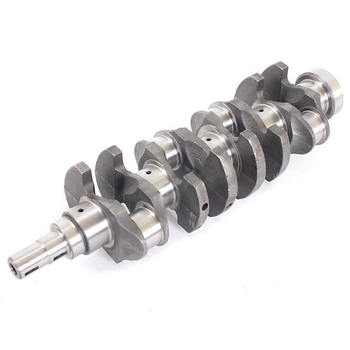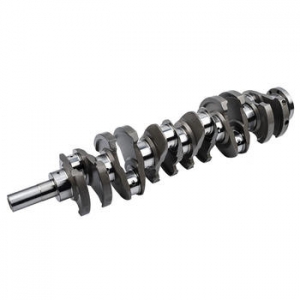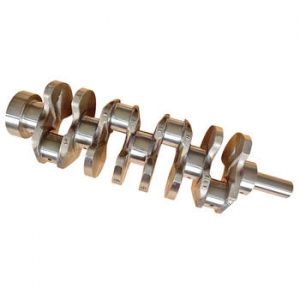Unveiling the Powerhouse: What Defines a Leading Crankshaft Company
Have you ever stopped to think about the unsung heroes beneath the hood of your car, or powering massive industrial machinery? Frankly speaking, it's easy to overlook the intricate components that make our modern world move. Among these, the crankshaft stands out as arguably the most critical mechanical component in an internal combustion engine. It's the very heart that converts the linear motion of pistons into rotational motion, driving everything from vehicles to power generators. And behind every robust engine, there's a dedicated Crankshaft company, tirelessly working to engineer and produce these vital parts.
To be honest, the journey of a crankshaft from raw material to a high-precision engine component is nothing short of fascinating. It involves a blend of advanced metallurgy, sophisticated engineering, and meticulous manufacturing processes. This article will delve deep into what makes a crankshaft company tick, exploring their pivotal role in various industries, the challenges they face, and the innovations shaping their future.
The Heart of the Engine: What a Crankshaft Company Does
At its core, a Crankshaft company is in the business of precision. They are responsible for designing, manufacturing, and often distributing crankshafts that meet the incredibly demanding specifications of various engine types. This isn't a simple task; crankshafts operate under immense stress, high temperatures, and continuous rotational forces, requiring exceptional material strength, dimensional accuracy, and perfect balance.
From Raw Material to Precision: The Manufacturing Process
The manufacturing process for a crankshaft is a testament to modern engineering capabilities. It typically begins with high-grade steel or cast iron, selected for its specific properties. Interestingly enough, the journey often starts with forging, where the raw material is heated and hammered into a rough shape, aligning the grain structure for superior strength and fatigue resistance. This initial step is crucial for the crankshaft's ultimate durability.
Following forging, the crankshaft undergoes a series of meticulous machining operations. This includes turning, milling, grinding, and drilling to achieve the precise dimensions, surface finishes, and bore alignments required. Each journal (the part that connects to the main bearings and connecting rods) must be perfectly concentric and smooth to minimize friction and wear. Many experts agree that the precision crankshaft manufacturing phase is where the true artistry and technical prowess of a company shine.
- Forging: Shaping the raw material for optimal strength.
- Machining: Achieving precise dimensions and surface finishes.
- Heat Treatment: Enhancing hardness and wear resistance.
- Balancing: Eliminating vibrations for smooth operation.
- Inspection: Rigorous quality checks using advanced metrology.
After machining, heat treatment processes like induction hardening or nitriding are applied to enhance the surface hardness and wear resistance of critical areas. Finally, the crankshaft is meticulously balanced to eliminate any vibrations during operation, a step that is paramount for engine longevity and performance. Every single step, from the initial design to the final inspection, is critical for ensuring the crankshaft's reliability and performance.

Engineering Excellence: Design and Innovation
Beyond manufacturing, a leading crankshaft company also excels in engineering design. They utilize advanced CAD/CAM software for modeling and simulation, allowing them to optimize designs for specific engine requirements, reduce weight, and improve performance. Material science plays a huge role here, as engineers constantly seek new alloys and composites that can withstand even greater stresses and temperatures. Stress analysis, using finite element analysis (FEA), helps predict how the crankshaft will behave under various load conditions, ensuring structural integrity before a single piece of metal is cut. In my experience, the best companies invest heavily in R&D to stay ahead of the curve.
Types of Crankshafts and Their Applications
While the fundamental principle remains the same, crankshafts vary significantly in design and material depending on their intended application. A reputable Crankshaft company will have expertise across a broad spectrum of industries.
Automotive Crankshafts: Powering Our Rides
This is perhaps the most common application. Automotive crankshafts are designed for a wide range of vehicles, from small passenger cars to heavy-duty trucks and buses. They need to be durable enough for millions of revolutions over years of service, yet also lightweight to improve fuel efficiency and reduce emissions. The design considerations for a 4-cylinder engine crankshaft differ vastly from those for a V8 or a large diesel truck engine, requiring specialized knowledge and manufacturing capabilities.
Industrial and Marine Crankshafts: Heavy-Duty Demands
When we talk about sheer size and power, industrial and marine crankshafts come to mind. These behemoths are found in massive power generation units, compressors, pumps, and the colossal engines that propel cargo ships across oceans. These crankshafts can weigh many tons and are designed for continuous, high-load operation, often for decades. The manufacturing tolerances for these large components are still incredibly tight, despite their size, making their production a truly specialized undertaking.
Specialty Crankshafts: Beyond the Ordinary
Beyond the mainstream, there are niche applications that demand highly specialized crankshafts. This includes high-performance motorsport engines, where weight reduction and extreme durability are paramount, or even aerospace applications for certain types of aircraft engines. These often require custom crankshaft solutions, pushing the boundaries of material science and manufacturing precision. It's worth noting that these specialty markets, while smaller in volume, often drive innovation that eventually trickles down to more common applications.
The Global Landscape of Crankshaft Companies
The crankshaft manufacturing industry is truly global, with key players spread across continents. The demand for these components is intrinsically linked to the automotive, marine, and industrial sectors, making it a barometer for global economic health.
Key Players and Market Trends
The market for crankshafts is dominated by a few large, established manufacturers, but there are also many smaller, specialized firms. These global crankshaft suppliers often have long-standing relationships with major engine manufacturers, acting as Tier 1 or Tier 2 suppliers. Market trends include a push towards lighter materials, more efficient designs, and stricter emission standards, which directly impact crankshaft design and production. The rise of electric vehicles, while a long-term threat to traditional internal combustion engines, also presents opportunities for crankshaft companies to diversify into components for hybrid systems or other rotating machinery.
Interestingly enough, many of these companies have global footprints, with manufacturing plants and distribution networks strategically located to serve diverse markets. This allows them to leverage economies of scale and respond quickly to regional demands.

Challenges and Opportunities in the Industry
The crankshaft industry faces several significant challenges. Volatility in raw material prices, particularly for steel and iron, can heavily impact production costs. Environmental regulations are becoming increasingly stringent, pushing companies to adopt more sustainable manufacturing processes and reduce their carbon footprint. The most significant long-term challenge, however, is the automotive industry's shift towards electrification.
However, with challenges come opportunities. The need for high-performance, lightweight crankshafts for hybrid vehicles and next-generation internal combustion engines (which will still be around for decades, especially in heavy-duty applications) continues to drive innovation. Furthermore, the expertise in precision machining and metallurgy possessed by a leading Crankshaft company can be leveraged for other high-precision rotating components in diverse industries, from renewable energy to aerospace.
Choosing the Right Crankshaft Company: What to Look For
For engine manufacturers, or even individuals looking for replacement parts, selecting the right crankshaft company is paramount. The quality of the crankshaft directly impacts engine performance, reliability, and longevity.
Quality Assurance and Certifications
A top-tier crankshaft company will adhere to stringent quality control standards. Look for certifications like ISO 9001, IATF 16949 (for automotive suppliers), or AS9100 (for aerospace). These certifications indicate a commitment to continuous improvement and a robust quality management system. They should have sophisticated metrology labs equipped with CMMs (Coordinate Measuring Machines) and other advanced inspection tools to ensure every dimension is within tolerance. Frankly speaking, without rigorous quality checks, even the best design can fail.
Customization and R&D Capabilities
The ability to provide custom crankshaft solutions is a significant differentiator. This means the company can work with clients to design and produce crankshafts tailored to unique specifications, whether for a new engine prototype or a specialized industrial application. A strong R&D department signals a forward-thinking company that is investing in new materials, manufacturing techniques, and design innovations. I've found that companies with strong R&D are often the most reliable partners for long-term projects.
After-Sales Support and Longevity
A good crankshaft company doesn't just sell a product; they offer comprehensive after-sales support. This includes technical assistance, warranty services, and the availability of replacement parts. A company with a long history and a strong reputation in the industry is often a safer bet, as it demonstrates their ability to adapt, innovate, and maintain customer satisfaction over time.
The Future of Crankshaft Manufacturing
The world is changing, and so is manufacturing. The future of the crankshaft industry will be shaped by several key trends, pushing companies to evolve and innovate.
Sustainable Practices and Green Manufacturing
Environmental consciousness is no longer optional. Future crankshaft companies will increasingly focus on sustainable manufacturing processes, reducing waste, optimizing energy consumption, and exploring recyclable materials. This includes initiatives like closed-loop water systems, energy-efficient machinery, and minimizing hazardous waste. It's worth noting that sustainable practices can also lead to cost efficiencies in the long run.
Automation, AI, and Industry 4.0
The adoption of advanced automation, artificial intelligence (AI), and the principles of Industry 4.0 will revolutionize crankshaft production. Smart factories, predictive maintenance, and AI-driven quality control systems will lead to unprecedented levels of efficiency, precision, and consistency. This will allow a Crankshaft company to produce higher quality components at a faster rate, while also reducing human error.
Adapting to the Electric Vehicle Revolution
While internal combustion engines will continue to be vital for many applications, especially in heavy-duty transport and industrial sectors, the automotive industry's pivot towards electric vehicles cannot be ignored. Crankshaft companies are already exploring new avenues, such as manufacturing components for electric motors, gearboxes, or even entirely new product lines that leverage their core competencies in precision machining and material science. The ability to diversify and adapt will be key to long-term success.
In conclusion, the role of a Crankshaft company is far more complex and critical than it might appear on the surface. They are at the forefront of mechanical engineering, blending traditional craftsmanship with cutting-edge technology to produce the very heart of countless machines that power our world. From the intricate dance of precision machining to the strategic foresight of global market trends, these companies are essential to the fabric of modern industry. As technology advances and global demands shift, the crankshaft industry will undoubtedly continue to innovate, ensuring that the world keeps turning, one revolution at a time.
What aspects of crankshaft manufacturing do you find most impressive, and how do you think the industry will adapt to future challenges? Share your thoughts!
For more detailed information, please visit our official website:Crankshaft company
About the author: Dr. Alistair Finch is a seasoned mechanical engineer with over two decades of experience in powertrain components and advanced manufacturing. Specializing in rotating machinery and material science, he has consulted for leading automotive and industrial firms worldwide. His insights into the intricate world of crankshaft production and future industry trends are highly regarded, making him a trusted voice in the field of precision engineering.
 Trusted Crankshaft company Man
Trusted Crankshaft company Man
 Professional Crankshaft Manufa
Professional Crankshaft Manufa
 Trusted Crankshaft Supplier: W
Trusted Crankshaft Supplier: W
 Trusted Crankshaft Manufacture
Trusted Crankshaft Manufacture
